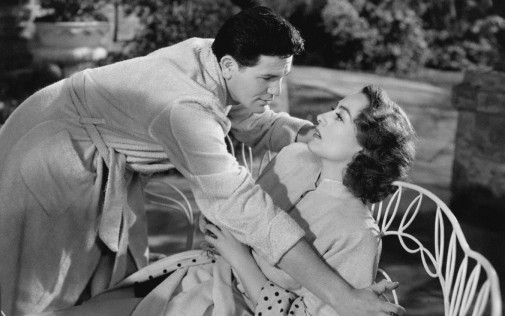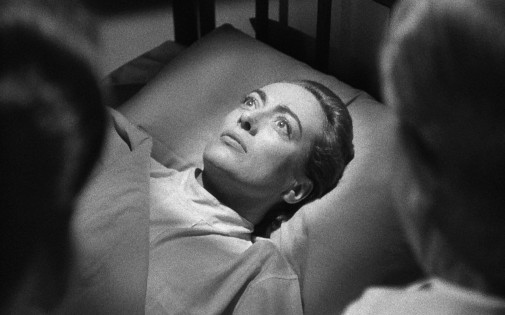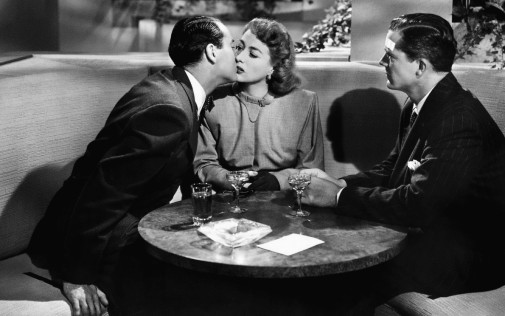Joan Crawford in '47
 Wednesday, May 27, 2020 at 10:30PM
Wednesday, May 27, 2020 at 10:30PM 
After more than a decade as one of MGM's brightest and most formidable stars, the 1940s were a turning point for Joan Crawford. While she struggled to reinvent herself during these middle years of her career, many of the actress's best movies came from this phase. She left behind a series of lackluster offerings from her original studio, finding new power when carefully choosing projects at her new home, Warner Brothers. It wasn't easy, but she triumphed, winning an Oscar for 1945's Mildred Pierce and going on to get two other Best Actress nominations. More importantly, she solidified her legacy, challenged herself as an actress, and proved to everyone she was more than a flapper or talentless glamour girl.
During this period of Crawford's filmography, 1947 was a particularly auspicious year. She broke our hearts in a romantic tragedy, impressed AMPAS with explosive neurosis, and went on to star in one of Hollywood's most interesting post-war melodramas…

While Humoresque, the remake of a Frank Borzage movie from 1920, premiered in 1946, it's wide release only happened in January of the next year. It was then that audiences were able to meet one of Crawford's most alluring creations. Playing second fiddle to John Garfield, she's a wealthy patron of the arts who falls in love with a prodigious violinist from humble beginnings. The plot of the movie ends in tragedy for Crawford's character, but the punitive narrative doesn't stop the star from exploring how one can bear one's soul for the camera while keeping a façade of pristine glamour. It's a beautiful performance and she's beautiful in the movie, so much so that this might represent the peak of her loveliness as a screen siren.

No matter how wonderfully Humoresque showcases Joan Crawford's abilities, hers is a borderline supporting role. Her other 1947 releases would feature her front and center and build themselves around her presence. The first of those pictures was Curtis Bernhard's Possessed, the first time the actress ventured into the murky waters of genre filmmaking with a tinge of horror. It also represents one of Crawford's most daring experiments when it comes to testing the plasticity of her star persona. Just look at the way she enters the film, stumbling catatonically through Los Angeles streets at dawn. Ashen faced and off the deep end, she's the zombified carcass of a romantic heroine whose turmoil wrecked her to the core.
A noirish flashback structure lets us see what brought upon the destruction of this woman. In that story, we find Joan Crawford playing up the mannered affectation that so many people nowadays point at as a signifier of hammy old-school film acting. That said, the actress' turn in Possessed is far from being an accidental turn to exaggerated histrionics. Quite the contrary, her approach to the role ends up being a canny implosion of movie star acting, the brittle artifice of it all crashing down into a cesspool of nervous paranoia. By the end of this unseemly spectacle, Crawford's erratic characterization may not present a fleshed-out human being, but it offers instead a portrait of paralyzing panic as a state of being.

Possessed conquered my admiration and it won Crawford a second Best Actress nomination. However, if asked what's her best movie from 1947, my answer wouldn't be that psychological horror. Instead, Otto Preminger's Daisy Kenyon earns the title, injecting a love triangle premise with the trauma of a world ravaged by war and the cynicism of an embittered society. Daisy Kenyon, the movie and the character, thus becomes a symbol for a generation of women who spent their entire adulthood fighting. First through the Great Depression, then through the war, until they reach middle-aged and are tired of all the struggle.
It's a complicated movie with no fully-likable characters, a weird experiment that exploits Joan Crawford's star power with sharp precision. Daisy Kenyon also embraces the mess that is its character's thorny relationships, creating a situation where a satisfying ending becomes something next to impossible. The pleasure of a happy conclusion is an impossible dream in the cosmos of this melodrama. Even the smiles of happiness feel vaguely hollow, devoid of the genuine mirth they might otherwise highlight. It's no wonder that the film earned dismissive reactions when it premiered, suffering even from its own makers' disinterest in the following years. Still, I'll always hold the picture dear to my heart as one of the best Joan Crawford vehicles.
If you're a Crawford fan, you'll be happy to know that these three movies are available online. Humoresque is available to stream on DirecTV. You can also rent it and those two other films from Amazon, Youtube, Google Play, and others.



Reader Comments (24)
Humoresque is officially a 1946 release. That's the year for which it competed at the Oscars. Franz Waxman's score was nominated. TFE is a big Oscar fan and prognosticator. Even though Cláudio mentions this, the premiere-wide release dichotomy is no excuse to dump the film into 1947.
Marcos -- I know it competed in the 1946 Oscars and am not trying to say otherwise. I'm sorry if it came off like that in the piece.
From an audience standpoint though, I thought it important to mention that its wide release happened in 1947 and include it in the piece. For most American audiences at the time, Humoresque would have only been seen in 1947 and not 1946, contributing to Joan Crawford's great year on the big screen. Still, because it's officially from the previous year I tried to give more importance to the other movies, giving them two paragraphs each and Humoresque only one.
I apologize if you think I'm unjustly dumping the movie into 1947. Hopefully, that issue is less impactful than the rest of the article and its praise of Joan Crawford. As always, thank you for the feedback.
OK Cláudio. I see your point. I was a bit vehement. You don't have to apologize. And, as I said, you did acknowledge the fact. In the last 10 years or so I've been particularly touchy when it comes to Oscar eligibility dates. Since then, the press is making us all crazy by beginning to refer to the Oscars by the year of the ceremony, and not the year of eligibility/release.
For my money, Crawford never topped her work in "Humoresque". It's a lightning bolt of a performance, electric with charisma,,assurance and finesse. She was riding high on her recent career changing "Mildred Pierce" triumph and her beautiful work in "Humoresque" just pulsates with renewed confidence. Dazzling.
I enjoy "Daisy Kenyon" but I think Dana Andrews steals the show. Like Crawford he was on a roll in the late 40's, racking up a brace of fine performances, this being one of his best.
Interestingly enough, Bette Davis, the reigning queen at Warner Brothers, passed on both Mildred Pierce and Humoresque. Given their differing acting styles, one wonders what characterization Davis would have brought to each role, and would have it made a better film?
She indeed is incredible in Daisy Kenyon and would've made a worthy nominee in 47. As I start to look into more 40's cinema I agree it was an incredible decade for Crawford. Of course her oscar winning role is central to greatness but in films like A Woman's Face, Flamingo Road & Above Suspicion she also showed herself so good.
Maybe I did not see anything, but we REALLY need to discuss that maverlous little masterpiece that is Pixar's "Out" and how groundbreaking it is, that Disney+ has released it. Also, I am really interested in possible backlash... 9 minutes of perfection.
Joan is sublime in POSSESSED - and if not for Roz, would be my Best Actress pick that year!
The post-War years until around 1950/1951 were good to Crawford and a number of established leading ladies like Gene Tierney, Olivia de Havilland, Rosalind Russell, and Loretta Young. Having played a lot of the same type of characters in films that created their stardom, they finally got a chance to break free from those roles and go deeper into different roles that showed the breadth of their talents.
A lot of Crawford's characters and films in her MGM years were interchangeable - shop girl aims for more in life, torn between the good but poorer guy and the richer but undeserving guy. There were some great roles for her in the period like Grand Hotel, The Women, and A Woman's Face, but many others were forgettable.
But as this article highlights, more interesting and memorable work came to her during this period. Flamingo Road is another favourite of mine from 1949. Not a great film by any means, but a lot of fun to watch. Watching Joan Crawford take on Sydney Greenstreet guarantees a good time on some level!
Crawford is fantastic in "Humoresque". She has great chemistry with Garfield. They make a very sexy couple.
Himoresque is a quality picture from top to bottom. I think Crawford recognized that which is why she accepted what is really a supporting role. It's a great supporting role, something else she surely realized and newly confident in her powers she handled it with sure handed aplomb. It's often cited as her best onscreen work and I agree. She's certainly aided by director Negulesco and cinematographer Ernest Haller as well as her surprisingly simpatico chemistry with John Garfield but she digs deep into Helen's complexity in bringing her to the screen. She never would have contemplated it at this point but she deserved a Supporting Actress nomination for the part.
Of the three Humoresque is my favorite but Possessed does contain an intense performance from Joan. During her catatonic scenes she comes across as somewhat mannered but in the other sections as her grip slowly starts to slip her work is more complicated. The weakness in the film is the miscasting of Van Heflin as the man she goes nuts over. Don't get me wrong I like Heflin as an actor a great deal but as someone who can drive a woman to madness he's out of place. There is always a feeling of level-headed decency that clings to him. The producers would have done better to cast Errol Flynn, borrowed either the just starting out Burt Lancaster or Kirk Douglas or reteamed her with Garfield.
I found Daisy Kenyon an interesting but rather slow picture with Joan and Hank Fonda kind of ill-matched. It does have a darkness that suits the period but of her films it's one I rarely return to.
I love this post, it made me want to see all 3 films again. For my money, Joan Crawford's career was at its artistic peak during this period, with other notable titles being Harriet Craig ('50) and 1952's sublime suspense thriller, Sudden Fear. She was finally free to display more range in what turned out to be some of her very best films. Very glad her work in this period is finally being reassessed, appreciated & celebrated by film historians.
Daisy Kenyon has one of best love triangles in film history, it would be a perfect film if it ended right after Crawford coming out of that wrecked car. Easily Crawford's finest and most underrated performance, she and Dana Andrews should both be nominated.
More Joan please,This was a really affectionate tribute to a much maligned star.
What I like about this post is the affection Claudio obviously for the Joan and has brought out the best in the comments from others,more Joan please.
Yes, as markgordonuk said: more Joan, please!
we should probably do a big series on Joan at some point since she has multiple fans here including me. (i hate the way FEUD and MOMMIE DEAREST have reduced her so much in people's eyes... they cant seem to get past the modern camp / salacious stuff to see what a phenomenal movie star she was.
That's what I feel sad about Nat,she's been boiled down to camp only and sometimes she was high camp but not all the time,only in that last Feud episode did we probably get a glimpse of the real Joan,Even before Mildred Pierce she was a huge star with lots of good - great films to her name,her waspy one liners in The Women all gay men of a certain age know.
Except for one moment or another, MGM made a lot of mistake when it comes to Crawford - the same with Grace Kelly who fought all the time with them and was suspended for refusing the roles offered when she was nominated for The Country Girl; luckily she had Hitchcock and George Seaton spinning around her. In the 1940s, Crawford has never been so beautiful, mature, playing women, no girls, and with great films. Believe me, MOMMIE DEAREST brought her a new world of fans, starting with me. 😉
I agree that Crawford should have made another picture with Garfield
Marcos Claudio was clearly talking about the year 1947, not Oscar year of 1947. Please reread before posting comments that are bitterly pedantic and already addressed inside the piece. Thank you and hope you are well. We don't need a repeat of the time period where Peggy Sue and thevoid99 captured the comment section hostage with 90 percent bitter postings.
Since Nathaniel is imminently going to conclude Seasons of Bette, maybe there is a Crawford equivalent in there for somebody to dive into?
Great piece! I also wouldn't mind a Crawford series from you after Nathaniel wraps up Seasons of Bette!
Yes, Crawford was indeed having a hot streak fr the 40s to early 50s, from A Woman's Face (1941) to Sudden Fear (1952).
I agreed tt Humoresque is her best restrained & understated performance. U cld tell tt she is holding back & she conveys so much w juz a glance, tears in her eyes, smoke in her face, drink in her hand...Her watery end is so iconic!!! She never get a part like this ever.
Possessed is a very good showcase, previewing her unnerved neurosis in Sudden Fear, Johnny Guitar, & Baby Jane